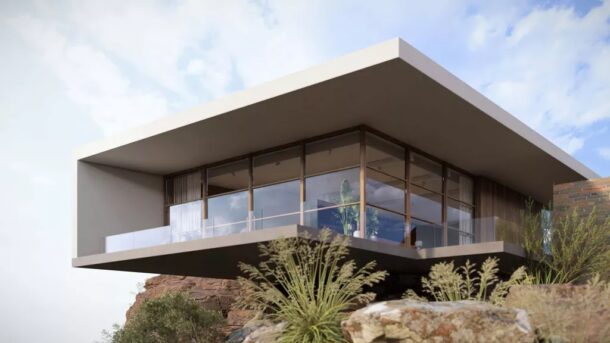With a completely redesigned rendering engine, Lumion 2023 marks the beginning of a new chapter for Lumion. Released earlier this month, the new rendering engine in Lumion 2023 offers much more sophisticated and natural-looking renders.
Lumion – Ray Tracing
Back in October 2022, Lumion announced that ray tracing would be added to Lumion. This was a massive undertaking and took the company some time.
Ray tracing comes to Lumion 2023. Picture shows how sunlight would cast shadows in a room. (Image: Lumion.)
It meant developers needed to rebuild its render engine virtually from scratch. In fact, over the past six months, Lumion’s development team has almost doubled in size. Consequently, Lumion 2023 is quite unlike any previous version of this software.
By entirely redesigning its rendering engine to incorporate ray tracing alongside rasterization, Lumion offers a design platform that creates accurate photorealistic imagery very quickly indeed.
Rasterization versus Ray Tracing
Lumion 2023’s hybrid rendering engine combines rasterization and ray tracing. However, unlike rasterization, ray tracing technology calculates how light behaves in the real world. With the ray tracing switched on, a render will automatically feature more realistic indirect lighting, non-screen space reflections, and contact shadows. The new ray tracing effect in Lumion also lets designers control the number of samples and bounces, giving users greater control over the final result.
Reflections
Reflections now work automatically whenever the ray tracing effect is enabled. With ray tracing, curved surfaces now show accurate reflections, removing the need for reflection planes. In the first implementation, the ray tracing effect will not support reflections of glass or water materials.
Soft shadows created by point or omnidirectional lights now look natural. Simply switch the ray tracing effect on and adjust the light intensity to watch the softness of your shadows change automatically. Area and line lights can instantly turn an interior scene into a convincing render, complete with lifelike shadows.
Emissive surfaces
Emissive surfaces now emit light and cast shadows just as they would in reality when ray tracing is enabled. With the new ray tracing effect enabled, the interaction between light and each surface results in astonishingly realistic textures. Users can also import their own textures or combine different bitmaps to create the desired effect.
What can Lumion 2023 be used for?
Lumion 2023 can be put to many uses. These include 3D design, building and landscape architecture, education, interior design, and urban planning. It can produce realistic light and shadows, high-quality textures, and has an extensive asset library.
Lumion 2023 also significantly reduces the time and effort required to create compelling, high-quality visualizations of the design. Designers can control the composition of their visualizations by rendering directly in your preferred aspect ratio and easily create animations with new camera presets. Users can also choose to import a camera path from an external program to create more complex animations.
Improved build mode
The brand-new Transform feature makes moving and aligning one’s models very straightforward. Designers can arrange assets exactly as necessary. Designers can also align objects to the walls, floors, and furniture more easily with the new-and-improved AutoSnap feature. It is also very easy to position and angle the virtual camera can too.
Improved materials
Lumion 2023 now has an improved glass material. This allows designers to fine-tune every last detail of their project’s windows and other glass surfaces. Users can also add custom textures such as frostiness. However, the new glass material is currently not fully compatible with ray tracing version 0.9.
Expanded material library
Lumion 2023 comes with 98 new materials that you can use to add realism to your buildings’ surfaces or landscape designs, including asphalt, brick, concrete, grass, metal, plaster, soil, stone, and wood.
The raster workflow in Lumion 2023’s enables designers to control subsurface scattering. Consequently, this gives objects a translucent effect, allowing light partially to penetrate the object and subtly scatter. It can also alter the tint of the scattered light by assigning a color to the material map.
Additionally, users can use the Clearcoat property available in Lumion Pro to add a layer of colorless, resin-like finish to surfaces for a more realistic appearance. Meantime, a new search function in the material library makes finding the materials much quicker and easier.
Future development
Lumion plans to extend its ray tracing effects. These will be available through the new software updater included in Lumion 2023. This will enable more frequent feature and content releases.
Compatibility
Lumion 2023 also automatically recognizes the materials assigned in your CAD software and applies them to your scene’s surfaces. When importing a 3D model, Lumion 2023 now recognizes and applies a corresponding material from the library to these surfaces. Consequently, Lumion 2023 is compatible with a wide range of industry-standard design and graphics tools, including:
- 3D Studio Max
- Autodesk Autocad
- Autodesk FormIt Pro
- Autodesk Revit
- BricsCAD
- Graphisoft ArchiCAD
- Nemetschek Allplan
- Nemetschek Vectorworks
- Rhinoceros
- Trimble SketchUp
Availability and Pricing
Existing Lumion users with an active subscription license can upgrade to Lumion 2023, straight from their accounts, at no additional cost. Lumion 2023 is available as a 1-year or 3-year subscription both for Standard and Pro editions. Customers with a perpetual Lumion license can now take advantage of promotional pricing when upgrading to Lumion 2023.
- Users may purchase these licenses from here.
- Lumion 2023 Pro is also available as a free 14-day trial. Please click here.
- It is also available free for students and educational faculties. For more information, please here.
- To learn more about how ray tracing works and its current limitations, please study the Lumion 2023 release notes here.
